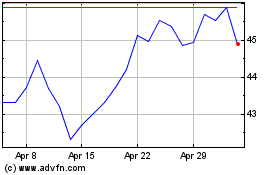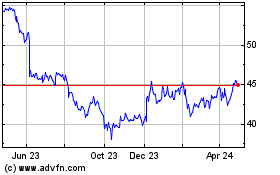Outlines Framework for Growth with New
Long-term Algorithm
Campbell Soup Company (NASDAQ:CPB) today held an Investor
Day at the Nasdaq MarketSite in New York City where Campbell’s
management team reviewed progress against the company’s
transformation and outlined plans for the next era of accelerated
growth.
Since 2019, the company has made significant progress in three
key areas:
- Transformed portfolio. Shifted focus to advantaged core
categories and geographies critical to fueling net sales and
earnings growth, including the acquisition of Sovos Brands.
- Rebuilt the foundation. Taken significant steps in
improving its execution and capabilities, touching nearly every
aspect of the company, including assembling an exceptional
leadership team, enhancing the culture and turning its supply chain
into a competitive advantage.
- Delivered on commitments. Built trust by consistently
delivering strong financial results, while also outperforming
consumer packaged goods peers on many key performance
indicators.
“For the last five years, we have been on a transformative
journey to redefine our company,” said Mark Clouse, Campbell’s
President and Chief Executive Officer. “Our focused strategy has
positioned us well and helped to solidify a foundation that has
delivered consistent and dependable results. We are ready to turn
the page and enter a new chapter where we build on Campbell’s
transformed portfolio, strong team, and aligned and engaged culture
with the goal to set the standard for performance in the food
industry.”
Mark Clouse, Chief Executive Officer; Carrie Anderson, Chief
Financial Officer; Chris Foley, President, Snacks and Mick
Beekhuizen, President, Meals & Beverages laid out the next
phase of Campbell’s growth plans, including a new long-term growth
algorithm to grow shareholder value.
New Long-term Growth Algorithm1 Increased on Topline
Organic Net Sales
+2 to +3%
Adjusted EBIT
+4 to +6%
Adjusted EPS
+7 to +9%
Setting the Standard for Performance
The company aims to set the standard for performance in the
industry with a new strategy, new mission and new name. As part of
its evolution and transformed portfolio, the company intends to
change its name to The Campbell’s Company, subject to shareholder
approval at its annual meeting of shareholders in November.
“This subtle yet important change retains the company’s iconic
name recognition, reputation and equity built over 155 years while
better reflecting the full breadth of the company’s portfolio,”
said Clouse.
The company’s Set the Standard mission is clear and measurable,
with five key pillars:
- Top Team. Foster an engaged and inclusive culture, while
building capabilities and developing leaders at all levels of the
organization.
- Best Portfolio. Drive growth through 16 leadership
brands which span across both Snacks and Meals & Beverages and
represent 84% enterprise sales and approximately 95% of the
company’s segment operating earnings in fiscal 2024.
- Winning Execution. Outperform the competition with an
advantaged supply chain, stepped-up innovation capabilities, strong
retailer relationships and effective deployment of new and evolving
technology.
- Top-Tier Performance. Leverage the company’s top team,
portfolio of best-in-class brands and operational capabilities to
deliver strong revenue, earnings growth, and operating cash
flow.
- Lasting Impact. Build on Campbell’s legacy of impact by
delivering measurable results against sustainability and community
goals.
“With the top team, the best portfolio of brands, a track record
of strong execution and performance, and a commitment to building
on our legacy of trust and impact, we have never been more prepared
to deliver top-tier performance and to be the most dependable and
most capable company in food,” said Clouse.
Full Potential Snacks
Chris Foley outlined the potential for continued long-term
growth and margin expansion in its Snacks division supported by its
elevated portfolio of leadership brands, a strong innovation
pipeline, and an advantaged direct store delivery model that offers
further scale opportunities.
“We have built the best snacks portfolio in faster growing and
advantaged categories,” said Foley, President, Snacks. “We expect
to continue to grow these advantaged core businesses by pursuing
best-in-class innovation and unlocking the full potential from our
advantaged distribution network. Our strategy is designed to
deliver margin expansion while making the necessary investments to
fuel growth for the future in a sustainable manner. We could not be
better positioned for leading the on-going growth and momentum in
snacking.”
Transforming Meals & Beverages
In its Meals & Beverages division, Mick Beekhuizen shared
how its portfolio of leadership brands is better positioned than
ever to meet consumers’ needs with continued focus on quality,
convenience and value. With the game-changing acquisition of Sovos
Brands, which elevates and strengthens its highly advantaged
portfolio, the division has a new growth trajectory for dependable
and profitable growth.
Beekhuizen noted that soup remains an important part of the
Meals & Beverages division but is now a smaller portion of the
transformed portfolio.
“Our Meals & Beverages transformation story is far from
complete, as we challenge ourselves to unlock the potential of our
portfolio of iconic and distinctive brands,” said Beekhuizen,
President, Meals & Beverages. “We intend to set the standard
for performance in the center store through our compelling consumer
engagement and exciting flavor-forward innovation, with Rao’s
strengthening and solidifying our potential and elevating our
overall portfolio.”
Top-Tier Performance
The company aims to deliver highly predictable and sustainable
top-tier results with a long-term algorithm that includes:
- Growing organic net sales at approximately 2% to 3%.
This target reflects a historically consistent expectation of 3-4%
on the Snacks business and a modest move up to 1-2% for the Meals
& Beverages business, supported by the Sovos Brands
acquisition.
- Long-term adjusted EBIT growth of approximately 4% to 6%
fueled by sustainable growth on topline and a variety of areas for
division specific and enterprise initiatives to drive faster bottom
line and margin expansion, including a new $250 million enterprise
cost savings program through fiscal 2028. This plan will also build
appropriate space for reinvestment back into the business.
- Delivering adjusted EPS growth of approximately 7% to 9%
through fiscal 2027 as the company grows adjusted earnings and
reduces interest expense as it deleverages its balance sheet.
“Our execution and capabilities to enable top-tier performance
have never been stronger,” said Carrie Anderson, Chief Financial
Officer. “With a refreshed long-term algorithm, we have a clear
roadmap for multi-year top- and bottom-line expansion. Our investor
proposition is compelling, with strong and growing internal cash
flow generation, providing multiple paths to create shareholder
value.”
_______________________1 Note: A non-GAAP reconciliation is not
provided for long-term targets as the company is unable to
reasonably estimate the full-year financial impact of items such as
actuarial gains or losses on pension and postretirement plans
because these impacts are dependent on future changes in market
conditions. The inability to predict the amount and timing of these
future items makes a detailed reconciliation of these
forward-looking financial measures impracticable.
About Campbell
For more than 150 years, Campbell (Nasdaq:CPB) has been
connecting people through food they love. Generations of consumers
have trusted us to provide delicious and affordable food and
beverages. Headquartered in Camden, N.J. since 1869, the company
generated fiscal 2024 net sales of $9.6 billion. Our portfolio
includes iconic brands such as Campbell’s, Cape Cod, Goldfish,
Kettle Brand, Lance, Late July, Milano, Michael Angelo's, noosa,
Pace, Pacific Foods, Pepperidge Farm, Prego, Rao's, Snyder’s of
Hanover, Swanson and V8. Campbell has a heritage of giving back and
acting as a good steward of the environment. The company is a
member of the Standard & Poor's 500 as well as the FTSE4Good
and Bloomberg Gender-Equality Indices. For more information, visit
www.campbellsoupcompany.com.
Forward-Looking Statements
This release contains “forward-looking statements” that reflect
the company’s current expectations about the impact of its future
plans and performance on the company’s business or financial
results. These forward-looking statements, including any statements
made regarding sales, EBIT and EPS guidance, rely on a number of
assumptions and estimates that could be inaccurate, and which are
subject to risks and uncertainties. The factors that could cause
the company’s actual results to vary materially from those
anticipated or expressed in any forward-looking statement include:
the risk that the cost savings and any other synergies from the
Sovos Brands, Inc. (“Sovos Brands”) transaction may not be fully
realized or may take longer or cost more to be realized than
expected, including that the Sovos Brands transaction may not be
accretive within the expected timeframe or the extent anticipated;
the risks related to the availability of, and cost inflation in,
supply chain inputs, including labor, raw materials, commodities,
packaging and transportation; the company’s ability to execute on
and realize the expected benefits from its strategy, including
growing sales in snacks and growing/maintaining its market share
position in soup; the impact of strong competitive responses to the
company’s efforts to leverage its brand power with product
innovation, promotional programs and new advertising; the risks
associated with trade and consumer acceptance of product
improvements, shelving initiatives, new products and pricing and
promotional strategies; the ability to realize projected cost
savings and benefits from cost savings initiatives and the
integration of recent acquisitions; disruptions in or
inefficiencies to the company’s supply chain and/or operations,
including reliance on key co-manufacturer and supplier
relationships; the risks related to the effectiveness of the
company's hedging activities and the company's ability to respond
to volatility in commodity prices; the company’s ability to manage
changes to its organizational structure and/or business processes,
including selling, distribution, manufacturing and information
management systems or processes; changes in consumer demand for the
company’s products and favorable perception of the company’s
brands; changing inventory management practices by certain of the
company’s key customers; a changing customer landscape, with value
and e-commerce retailers expanding their market presence, while
certain of the company’s key customers maintain significance to the
company’s business; product quality and safety issues, including
recalls and product liabilities; the possible disruption to the
independent contractor distribution models used by certain of the
company’s businesses, including as a result of litigation or
regulatory actions affecting their independent contractor
classification; the uncertainties of litigation and regulatory
actions against the company; the costs, disruption and diversion of
management’s attention associated with activist investors; a
disruption, failure or security breach of the company’s or the
company's vendors' information technology systems, including
ransomware attacks; impairment to goodwill or other intangible
assets; the company’s ability to protect its intellectual property
rights; increased liabilities and costs related to the company’s
defined benefit pension plans; the company’s ability to attract and
retain key talent; goals and initiatives related to, and the
impacts of, climate change, including weather-related events;
negative changes and volatility in financial and credit markets,
deteriorating economic conditions and other external factors,
including changes in laws and regulations; unforeseen business
disruptions or other impacts due to political instability, civil
disobedience, terrorism, geopolitical conflicts, extreme weather
conditions, natural disasters, pandemics or other outbreaks of
disease or other calamities; and other factors described in the
company’s most recent Form 10-K and subsequent Securities and
Exchange Commission filings. This discussion of uncertainties is by
no means exhaustive but is designed to highlight important factors
that may impact the company’s outlook. The company disclaims any
obligation or intent to update forward-looking statements in order
to reflect new information, events or circumstances after the date
of this release.
View source
version on businesswire.com: https://www.businesswire.com/news/home/20240909980421/en/
INVESTOR CONTACT: Rebecca Gardy
(856) 342-6081 Rebecca_Gardy@campbells.com
MEDIA CONTACT: James Regan (856)
219-6409 James_Regan@campbells.com
Campbell Soup (NYSE:CPB)
Historical Stock Chart
From Dec 2024 to Jan 2025

Campbell Soup (NYSE:CPB)
Historical Stock Chart
From Jan 2024 to Jan 2025
